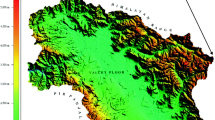Abstract
In northeast Thailand, the rapid expansion of rainfed paddy fields has decreased the stability of rice production. This paper describes a model that computes rice production on the basis of the hydrologic conditions of rainfed paddy fields on hill slopes. The model well expressed the hydrologic processes, rice yield, and production at the study site. We simulated rice production as uphill paddy plots are abandoned, increasing catchment area, under various rainfall conditions. The simulation showed that rice yield and stability increase as uphill plots are abandoned, although the total rice production decreases. Thus, the effect of catchment size on rice production in each plot was quantified. The model proved to be useful for analyzing rainfed rice production under various land and water conditions.















Similar content being viewed by others
References
Doorenbos J, Kassam AH (1986) Yield response to water. FAO Irrigation and Drainage Pap 33. FAO, Rome, pp 125–130
Fukui H, Chumphon N, Hoshikawa K (2000) Evolution of rain-fed rice cultivation in northeast Thailand: increased production with decreased stability. Global Environ Res 3(2):145–154
Goto A (2001) Modes of irrigation water use in northeast Thailand and the Angkor area. Sophia Asian Study 18:121–130
Kono Y (1985) Land, water and productivity of rainfed rice cultivation in tropical monsoon Asia (in Japanese). Doctoral Diss, University of Tokyo
Miyagawa S (1997) Simulation of water use improvement effect in rain-fed rice cultivation in northeast Thailand. Jpn J Trop Agric 41(4):275–285
Panigrahi B, Panda SN (2001) Simulation of ponding and soil moisture status through water balance model for rainfed upland rice. Agric Eng J 10:39–56
Suzuki K, Goto A, Mizutani M, Sriboonlue V (1999) Analysis of stability of rainfed rice cultivation in northeast Thailand. Southeast Asian Stud 37(1):50–64
Suzuki K, Goto A, Mizutani M, Sriboonlue V (2001) Modeling of hydrologic processes in rainfed paddy fields in northeast Thailand (in Japanese). Trans Jpn Soc Irrig Drainage Reclam Eng 212:79–84
Suzuki K, Goto A, Mizutani M, Sriboonlue V (2002) Model development for estimating rice production in rainfed paddy fields in northeast Thailand (in Japanese). J Jpn Agric System Soc 18(1):55–60
Wopereis MCS, Tuong TP, Kropff MJ (1995) Challenges and advances in simulation modeling of rainfed lowland rice systems: fragile lives in fragile ecosystems. In: Proc Int Rice Research Conf, International Rice Research Institute, Philippines
Acknowledgments
We would like to extend sincere thanks to Ms. Ayumi Yuki and Ms. Yu Mitsugi, formerly undergraduate students of the Faculty of Agriculture, Utsunomiya University, Japan, for their assistance.
Author information
Authors and Affiliations
Corresponding author
Rights and permissions
About this article
Cite this article
Suzuki, K., Goto, A., Mizutani, M. et al. Simulation model of rainfed rice production on sloping land in northeast Thailand. Paddy Water Environ 1, 91–97 (2003). https://doi.org/10.1007/s10333-003-0017-0
Received:
Accepted:
Published:
Issue Date:
DOI: https://doi.org/10.1007/s10333-003-0017-0




